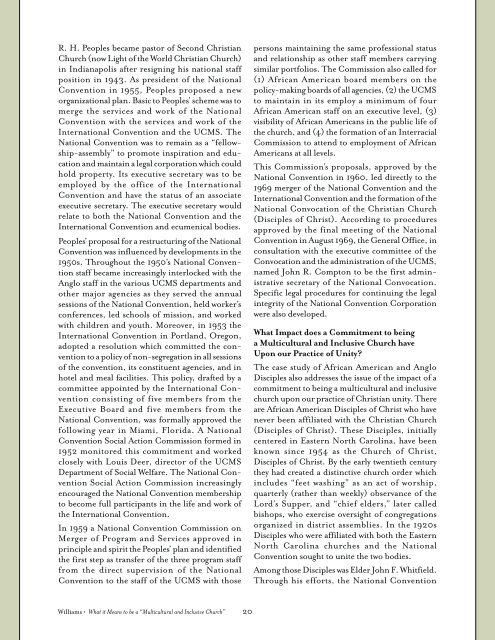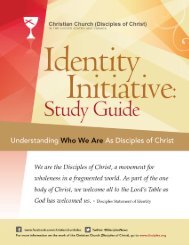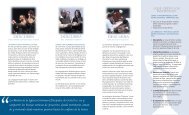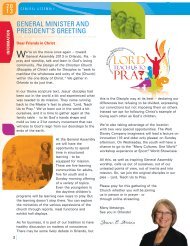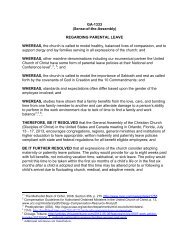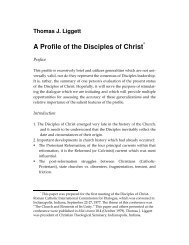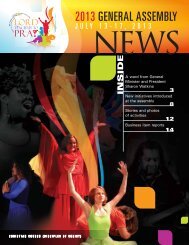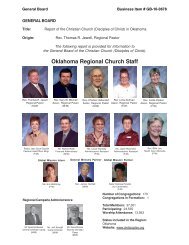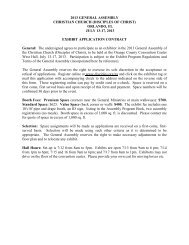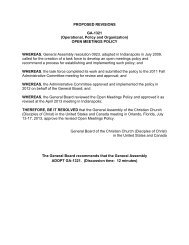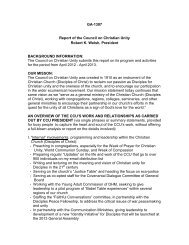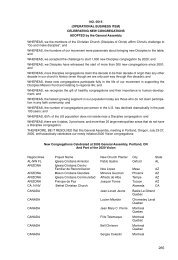RESOURCING THE CHURCH FOR ECUMENICAL MINISTRy A ...
RESOURCING THE CHURCH FOR ECUMENICAL MINISTRy A ...
RESOURCING THE CHURCH FOR ECUMENICAL MINISTRy A ...
You also want an ePaper? Increase the reach of your titles
YUMPU automatically turns print PDFs into web optimized ePapers that Google loves.
R. H. Peoples became pastor of Second Christian<br />
Church (now Light of the World Christian Church)<br />
in Indianapolis after resigning his national staff<br />
position in 1943. As president of the National<br />
Convention in 1955, Peoples proposed a new<br />
organizational plan. Basic to Peoples’ scheme was to<br />
merge the services and work of the National<br />
Convention with the services and work of the<br />
International Convention and the UCMS. The<br />
National Convention was to remain as a “fellowship-assembly”<br />
to promote inspiration and education<br />
and maintain a legal corporation which could<br />
hold property. Its executive secretary was to be<br />
employed by the office of the International<br />
Convention and have the status of an associate<br />
executive secretary. The executive secretary would<br />
relate to both the National Convention and the<br />
International Convention and ecumenical bodies.<br />
Peoples’ proposal for a restructuring of the National<br />
Convention was influenced by developments in the<br />
1950s. Throughout the 1950’s National Convention<br />
staff became increasingly interlocked with the<br />
Anglo staff in the various UCMS departments and<br />
other major agencies as they served the annual<br />
sessions of the National Convention, held worker’s<br />
conferences, led schools of mission, and worked<br />
with children and youth. Moreover, in 1953 the<br />
International Convention in Portland, Oregon,<br />
adopted a resolution which committed the convention<br />
to a policy of non-segregation in all sessions<br />
of the convention, its constituent agencies, and in<br />
hotel and meal facilities. This policy, drafted by a<br />
committee appointed by the International Convention<br />
consisting of five members from the<br />
Executive Board and five members from the<br />
National Convention, was formally approved the<br />
following year in Miami, Florida. A National<br />
Convention Social Action Commission formed in<br />
1952 monitored this commitment and worked<br />
closely with Louis Deer, director of the UCMS<br />
Department of Social Welfare. The National Convention<br />
Social Action Commission increasingly<br />
encouraged the National Convention membership<br />
to become full participants in the life and work of<br />
the International Convention.<br />
In 1959 a National Convention Commission on<br />
Merger of Program and Services approved in<br />
principle and spirit the Peoples’ plan and identified<br />
the first step as transfer of the three program staff<br />
from the direct supervision of the National<br />
Convention to the staff of the UCMS with those<br />
Williams • What it Means to be a “Multicultural and Inclusive Church”<br />
20<br />
persons maintaining the same professional status<br />
and relationship as other staff members carrying<br />
similar portfolios. The Commission also called for<br />
(1) African American board members on the<br />
policy-making boards of all agencies, (2) the UCMS<br />
to maintain in its employ a minimum of four<br />
African American staff on an executive level, (3)<br />
visibility of African Americans in the public life of<br />
the church, and (4) the formation of an Interracial<br />
Commission to attend to employment of African<br />
Americans at all levels.<br />
This Commission’s proposals, approved by the<br />
National Convention in 1960, led directly to the<br />
1969 merger of the National Convention and the<br />
International Convention and the formation of the<br />
National Convocation of the Christian Church<br />
(Disciples of Christ). According to procedures<br />
approved by the final meeting of the National<br />
Convention in August 1969, the General Office, in<br />
consultation with the executive committee of the<br />
Convocation and the administration of the UCMS,<br />
named John R. Compton to be the first administrative<br />
secretary of the National Convocation.<br />
Specific legal procedures for continuing the legal<br />
integrity of the National Convention Corporation<br />
were also developed.<br />
What Impact does a Commitment to being<br />
a Multicultural and Inclusive Church have<br />
Upon our Practice of Unity?<br />
The case study of African American and Anglo<br />
Disciples also addresses the issue of the impact of a<br />
commitment to being a multicultural and inclusive<br />
church upon our practice of Christian unity. There<br />
are African American Disciples of Christ who have<br />
never been affiliated with the Christian Church<br />
(Disciples of Christ). These Disciples, initially<br />
centered in Eastern North Carolina, have been<br />
known since 1954 as the Church of Christ,<br />
Disciples of Christ. By the early twentieth century<br />
they had created a distinctive church order which<br />
includes “feet washing” as an act of worship,<br />
quarterly (rather than weekly) observance of the<br />
Lord’s Supper, and “chief elders,” later called<br />
bishops, who exercise oversight of congregations<br />
organized in district assemblies. In the 1920s<br />
Disciples who were affiliated with both the Eastern<br />
North Carolina churches and the National<br />
Convention sought to unite the two bodies.<br />
Among those Disciples was Elder John F. Whitfield.<br />
Through his efforts, the National Convention


